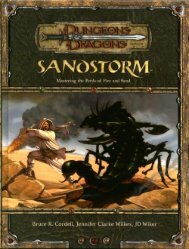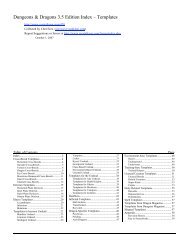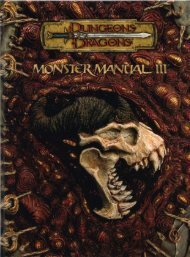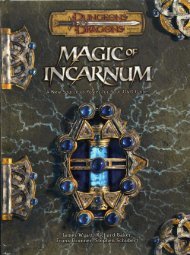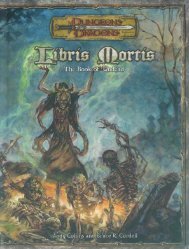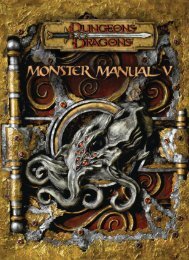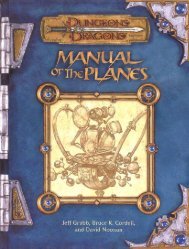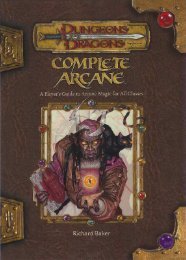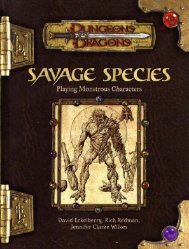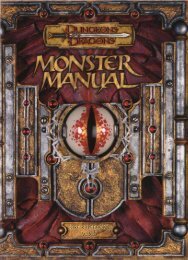Epic Level Handbook
Epic Level Handbook
Epic Level Handbook
- No tags were found...
Create successful ePaper yourself
Turn your PDF publications into a flip-book with our unique Google optimized e-Paper software.
Development Time: Developing an epic spell takesone day for each 50,000 gp in resources required todevelop the spell, rounded up to whole days.XP Cost: To develop an epic spell, you must spend1/25 of its resource price in experience points.Adding Seed DCs: When two or more epic seeds arecombined in an epic spell, their base Spellcraft DCs areadded together. Both contribute toward the spell’s finalSpellcraft DC.Determining School: When combining two or moreseeds to develop an epic spell, the school of the finishedspell is decided by the caster from among the seeds thatmake up the epic spell.Combining Descriptors: When two or more epicseeds are combined in an epic spell, all the descriptorsfrom each seed apply to the finished spell.Combining Components and Casting Times:Almost every epic spell has verbal and somatic componentsand a 1-minute casting time, regardless of thenumber of epic seeds combined. The only exceptions areepic spells with the heal and life seeds, which have divinefocus components.Combining Range, Targets, Area, and Effect: Oneseed might have a range of 12,000 feet, another seedmight have a range of 400 feet, and a third seed might nothave a range at all. Likewise, some seeds have targets,while others have an effect or an area. To determinewhich seed takes precedence in the finished epic spell,you must decide which seed is the base seed. The seedmost important to the spell’s overall purpose is the baseseed, and it determines the casting time, range, target,and so on. The other seeds apply only their specificeffects to the finished spell.For example, consider an epic spell that blasts all targetsin an area, then compels all the survivors to surrender.The seed that provides the blast is the base seed, so itsrange and targeting criteria are used in the finished spell.It is occasionally difficult to determine a base seed byexamining the spell’s effects. If you’re stuck, simply pickone seed for the purposes of making this determinationafter consulting with your DM.Combining Durations: When combining two ormore seeds to develop an epic spell, the seed with theshortest duration determines the duration of the finishedepic spell. If any seed of an epic spell is dismissible by thecaster, the epic spell is dismissible.Saving Throws: Even if more than one seed has anassociated saving throw, the final spell will have only asingle saving throw. If two or more seeds have the samekind of saving throw (Fortitude, Reflex, or Will), thenyou’ll obviously use that for the spell’s saving throw. If theseeds have different kinds of saving throws, simplychoose the saving throw that seems most appropriate forthe final spell.Spell Resistance: When combining two or moreseeds to develop an epic spell, if even one seed is subjectto spell resistance, the finished epic spell is subject to itas well.Factors: Factors are not part of epic seeds, but they arethe tools used to modify specific parameters of any givenseed. Applying factors to the seeds of an epic spell canincrease or decrease the final Spellcraft DC, increase theduration, change the area of a spell, and affect many otheraspects of the spell.There are three kinds of factors:1. Those that can affect a number of seeds. For example,the “1-action casting time” factor reduces the casting timeof an epic spell no matter what seeds you use to make it.If you choose this factor, you’ll add +20 to the SpellcraftDC of the epic spell.2. Those that can only be used with specific seeds. Thesummon seed, for example, lets you summon an outsiderof CR 2 or less. But for each +1 CR of the summoned outsider,the Spellcraft DC is increased by +2. This factoronly applies to epic spells with the summon seed.3. Those that reduce the Spellcraft DC rather thanincreasing it. These are referred to as mitigating factors.To calculate the final Spellcraft DC of an epic spell correctly,it’s important to determine the mitigating factorslast, after all the factors that increase the DC have beenaccounted for.Development Is an Art: Be creative when combiningseeds and factors. Many times developing a completelynew epic spell requires some guesswork and rule stretching.As with making and pricing magic items, a sort ofbalancing act is required. Often, you will need to stretchthe description of a seed to meet your needs. Developingobscure, unusual epic spells is possible, even if you aren’tsure how to put together the seeds and factors. If yourbest effort passes the DM’s examination, then your epicspell is good. If necessary, assess an “ad hoc” Spellcraft DCadjustment for any effect that cannot be extrapolatedfrom the seeds and factors presented here—the examplespells in this chapter use ad hoc factors frequently. In allcases, the DM determines the actual Spellcraft DC of thenew spell (see Behind the Curtain: Setting <strong>Epic</strong> SeedSpellcraft DCs).For example, you may want to develop a spell thatmoves an enemy’s soul into an inanimate object. Noseed specifically describes this ability. It’s time to becreative. You see that the transport seed might providethe basic effect you are after; you are moving something,even if it’s not physical. Knowing you’ll laterneed your DM’s approval, you decide that the transportseed could be used to transport a soul instead of a body,without adjusting the DC. (The target will of courseget a Will save, even if you succeed at touching thetarget.) Normally, you can’t transport a physical objectinto another one, but because you’re transporting anintangible “object” into a physical object, you hopeyour DM will be lenient. The DM might decide toimpose an ad hoc factor of +4 DC, which would be fair.You also realize that to trap an insubstantial soul in aphysical object, you’ll have to use the compel seed aswell, forcing the soul to remain within the object yousend it to.CHAPTER 2:EPIC SPELLS89



